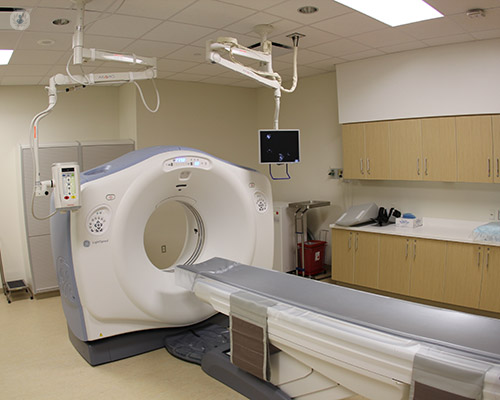CT urography
Dr Paul Crowe - Interventional radiology
Created on: 07-22-2015
Updated on: 05-03-2023
Edited by: Conor Dunworth
What is a CT urography?
A CT urography is a scanning technique which uses contrast material and imaging to show if there is blood in the urine and also to show kidney or bladder stones or cancer in the urinary tract, using a CT scanner to guide the process. The CT scanner produces images of cross-sections of the urinary tract and bladder which when assembled create a multidimensional image.

What does a CT urography involve?
During a CT urography, you lie on a narrow exam table which slides into the CT machine. In here the x-ray detectors within the CT machine rotate around you to create images of your internal anatomy. These images are compiled and developed by a special computer program. If contrast material is used, to highlight any blockages for example, then it will be injected through an IV line. It is an outpatient procedure.
Why is a CT urography done?
A CT urography is commonly used to detect problems in the kidneys, bladder, urinary tract and ureter. The following are the main issues detected with a CT urography:
- Blood in the urine (haematuria)
- Cancers
- Kidney or bladder stones
Preparation for a CT urography:
On the day of the CT urography, it is advisable to wear loose-fitting clothing, but you may be given a gown to wear during the scan. You should remove glasses, jewellery, or any objects containing metal before the scan as they could interfere with the CT scanner. You will be given special guidelines about food and drink consumption prior to the scan, however, sometimes you will be asked to drink water beforehand to distend the bladder. If contrast material is being used, you may be asked to avoid eating a few hours before the scan.
What to expect during a CT urography:
A CT urography is painless and generally quite fast. You might experience discomfort from having to lie still for a period of time, and you might be asked to hold your breath at certain points during the scan. However, pillows and straps might be used to make staying still easier. If contrast material is used, you may experience a warm sensation when it is injected. Once the scan is complete, the radiologist will ensure the images are acceptable, and if contrast material has been used, the IV line is removed once the scan is finished.
What do abnormal results mean?
If your results indicate any of the above abnormalities, more images might be taken as well as further tests. Your radiologist will interpret the results and share a report with your doctor.
Developments with CT urography scans:
The newest CT scanners can take scans of large sections of the body in a few seconds, which makes staying still much easier.
